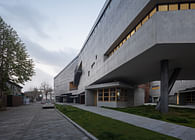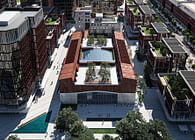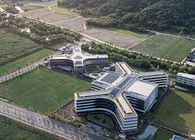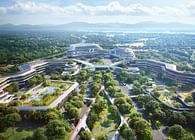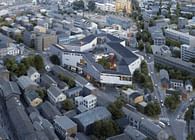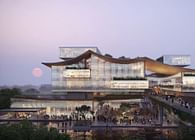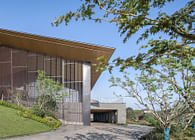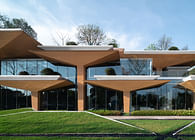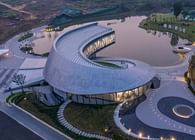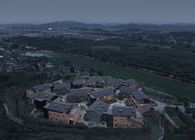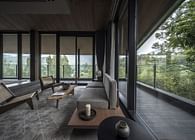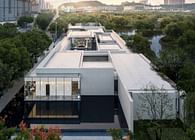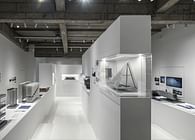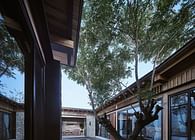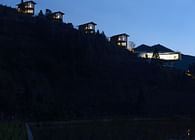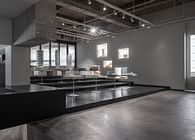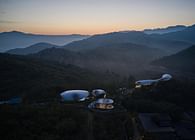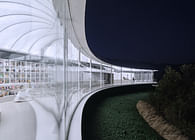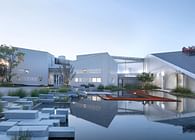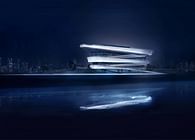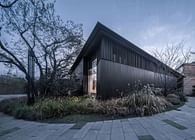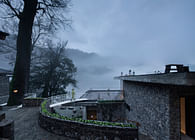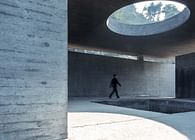
"New technologies are constantly breaking the boundaries of traditional architecture, driving a revolution in construction. Ultimately, this will establish a new spatial consensus: the architecture of the future may not be ' solidified' music, but rather dynamic scenes." — Zhu Peidong
Zhu Peidong, Co-Founder and Chief Architect of line+ studio, together with the team, collaborated with RoboticPlus.AI to research and develop China's first overall dynamic architecture—Lotus by the Xiangjiang River in Changsha. This project, through interdisciplinary integration and adaptive dynamic changes, explores the expansion of architectural boundaries with new technologies and provides new possibilities for diverse future spatial usage scenarios.
01. Respond to Site Conditions, Explore Technological Boundaries: A New Attempt in Spatial Production Methods
The project is located on the banks of the Xiang River in Changsha, serving as the city's living room, with dual attributes of urban viewing and regional landmark.
Due to constraints such as vegetation along the riverbank obscuring the site, it's necessary to achieve sufficient height to fulfill both the requirements of scenic viewing and landmark status. However, simply elevating the structure might block sightlines of surrounding buildings, potentially compromising the commercial value of the riverside community. On the other hand, the interior space needs to adapt to the user's requirement for scene switching on different occasions, with varying specific demands for privacy and openness.
As time progresses, the uncertainty of spatial usage increases. The current context of "environment-demand-space-technology" is constantly being disrupted, and the dynamic architecture has the new opportunity. In this project, we aim to dynamically respond to the different spatial states required for various activities or events, thereby forming an interactive structure of "people-activities/events-architecture-environment". After refining the project's series of internal and external demands, the design targets dynamic adjustments in spatial elevation and changes in transparency/privacy of the envelope. Through means such as the vertical movement of the main space and the opening/closing of the outer skin, the design flexibly and variably responds to the surrounding environment and spatial requirements, creating a multidimensional integration of architectural structure, landscape interface, and spatial experience.
In recent years, new technologies have triggered revolutionary advancements in many industries, yet there have been relatively few breakthroughs in the field of architecture. However, we believe that with the innovation of technology and the exploration of design, future architecture will no longer be merely static displays but dynamic organic spaces capable of actively responding to environmental changes and meeting diverse human needs.
02. Unfolding Posture: Dynamic and Variable Spatial Forms
The overall concept of the building involves the elevation of the main space, corresponding to two types of activities: viewing and meetings, and two types of space forms: presentation and concealment. At the individual level, it is an integrated responsive system. By adopting an industrial design approach, we first determined that the building would consist of the main space and movable mechanical devices. We then utilized vertical displacement to alter the connection between the main space and different floors of the east-side building, facilitating the transition between the two circulations.
Under the dynamic instruction of open display, the observation hall ascends from the corridor to the rooftop level, with the deployable skin unfolding outward. This creates a transparent viewing perspective facing the Xiangjiang River. Conversely, when it comes to closed folding, the observation hall descends, and the deployable skin contracts to form a private space. The overall process resembles the dynamic unfolding of a flower, shaping the spatial form of the project.
In the deepening development of form design, we aim to seek morphological imagery with universal recognizability within the path of modular design and standardized architectural components, thereby strengthening resonance and interaction with the urban public. The deployable skin, divided into nine sections within the operable range, is optimized based on the overlap of "petals" and the opening angle, resulting in a combination of four outer pieces (7m*5m) and five inner pieces (6m*6m), all adorned with rounded hexagonal edges, using transparent ETFE membrane as the main material.
The central observation hall evolves from a truncated conical base, responding to the vivid spatial effect under the clustering of petals, enveloped entirely by double-curved glass.
03. Technological Integration: Load-bearing Systems and Mechanical Technologies
The complex load-bearing system and reliable mechanical technology ensure the stability and dynamic effects of the building.
A load-bearing system integrating steel structure, glass curtain walls, and MEP (Mechanical, Electrical, and Plumbing) components is employed to ensure the purity and visual transparency of the internal space. The main structure features a rigid chassis at the base, with top beams arranged according to folding forms and flat trusses set along the perimeter. To achieve as much pure space and transparency as possible, the columns are integrated with the glass curtain wall mullions to form a unified column system. Firefighting, drainage, air conditioning, and other equipment components are integrated into the column system, with pipes routed through openings in locations with minimal stress. The roof system is divided into zones to accommodate windows, smoke extraction, firefighting, ventilation, and other requirements.
To meet the daily high-frequency usage demands and ensure the reliability of the mechanical systems, the dynamic lifting and lowering mechanical technology utilizes a "hydraulic scissor brace + flexible column" system, achieving comprehensive factors such as stability, comfort, safety, and maintainability.
Each petal in the deployable skin system is connected to the bottom hydraulic rod via a double-curved steel frame, allowing for an orderly opening and closing in a staggered arrangement. The dynamic effect of the skin is achieved through an intelligent linkage system consisting of "motor + reducer + large turntable," enabling different levels of petal opening based on programmed settings for angle and speed. This allows for the transition between different usage scenarios of the building and responds to the visual demands of the surrounding office and residential units for the landscape.
04. Interactive Smart Manufacturing: Interactive Digital Design and Intelligent Construction
In this project, interdisciplinary knowledge exchange transforms the traditional unidirectional path of construction from "demand-design-drawing-construction" into a winding and interactive working method.
During the stages of design refinement and production construction, line+ collaborates closely with RoboticPlus.AI, enabling full-process digital design optimization, intelligent factory component production, and prefabricated construction installation. This ensures the project's entire lifecycle, from design to implementation, is efficiently precise and controllable.
Digital Technology and Optimization Algorithms: line+ integrates deeply from Rhino to Revit, combined with the developed industrial software RoBIM by RoboticPlus.AI. This integration allows for comprehensive simulation of model installation for all steel structures using prefabrication techniques. It includes spatial cutting, perforation, calibration, and assembly positioning of steel components, incorporating construction details into the overall design and processing data. This process reduces errors and improves efficiency.
Building Production Information Model: The BIM model from the design end undergoes precision refinement, down to each component of every system, achieving the accuracy standard of LOD400. This model can be directly connected to component production factories, supporting the simulation of the entire process from transportation, loading and unloading, stacking, and lifting, to installation of components. This enhances the precision of engineering project management to the level of industrialized construction.
Intelligent Flexible Production: During the construction phase, the RoBIM platform integrates all model information, enabling data exchange between different intelligent processing equipment and automating the CNC production process. This includes using 7-axis robotic arms for component welding in the factory, synchronized with prefabrication assembly.
Virtual Construction Simulation: After prefabrication, the components are disassembled into several large pieces based on transportation conditions, loaded onto trucks, and quickly hoisted into place on-site, achieving the industrialized manufacturing of customized buildings. Virtual simulation plans are utilized, synchronizing mechanical devices with steel structure construction, optimizing construction sequences, and ensuring project timelines.
Remark
"Architecture is solidified music," with traditional construction methods and supporting structures determining its static nature. Lotus by the Xiangjiang River seeks to create a new experiential urban public space through the design and construction path of industrial devices. Supported by new technologies such as digital modeling, simulation, and smart construction, it attempts to break through the dimensional limitations of traditional architecture, creating a feasibility sample for holistic dynamic architecture—space is no longer static; it can also be fluid and changing.
On the other hand, the rise of new technologies such as artificial intelligence and the development trend of new architectural industrialization are gradually changing the traditional ecological chain relationship between architects and builders. Through the architectural technology exploration of this urban vignette, we hope to empower the urban environment and respond to the uncertainty of rapid evolution with a new architectural productivity, echoing the quietly changing times.
Status: Built
Location: Changsha, CN
Firm Role: Architecture
Additional Credits: Project Name: Lotus by the Xiangjiang River in Changsha
Design Firm: line+ studio
Chief Architect/Project Principal: Zhu Peidong
Design Team: Li Binmiao, Bian Qian, Duan Xiajing, Xu Zifeng, Zhang Daozheng
Client: Greentown China
Intelligent Construction: RoboticPlus.AI
Project Location: Hunan, Changsha
Floor Area: 78m²
Design Period: 2021.07 - 2022.01
Construction Period: 2022.02 - 2022.07
Structure: Steel Structure
Materials: ETFE Membrane, Curved Glass
Photography: CAAI_image · LI YI






